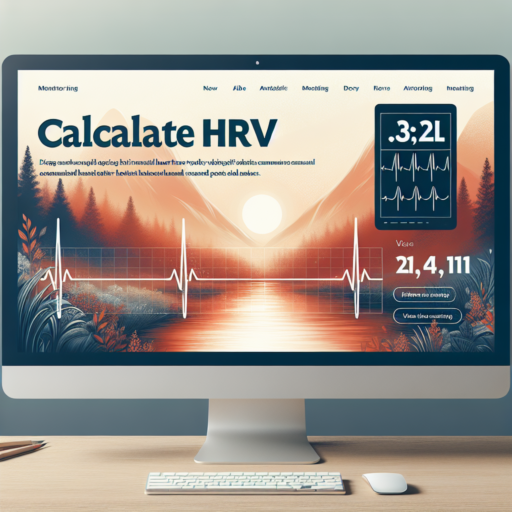Understanding Nightly Average HRV: What You Need to Know
Monitoring your Heart Rate Variability (HRV) can offer critical insights into your autonomic nervous system, especially during rest periods like sleep. Nightly average HRV is a pivotal metric that reflects your body’s ability to handle stress, recover, and adapt to different physical and mental conditions. It captures the variations in time between your heartbeat intervals over the course of the night, offering a comprehensive view of your physiological resilience and wellbeing.
HRV is not just a measure of heart health but a window into the balance between the sympathetic «fight or flight» and the parasythetic «rest and digest» nervous systems. A higher nightly average HRV indicates a robust and responsive stress-recovery cycle, signifying better cardiovascular fitness, stress management, and overall health. Conversely, a consistently low HRV can point to chronic stress, fatigue, or underlying health issues needing attention.
To effectively utilize HRV data, it’s essential to track it over time and observe trends rather than fixating on day-to-day fluctuations. Factors such as exercise intensity, stress levels, sleep quality, and even alcohol consumption can influence your nightly HRV average. By understanding these patterns, you can make informed lifestyle adjustments to enhance your HRV and, by extension, your overall health and well-being.
How to Improve Your Nightly Average HRV for Better Health
Improving your nightly average Heart Rate Variability (HRV) is crucial for enhancing overall health and wellness. HRV, a measure of the variation in time between each heartbeat, is considered a strong indicator of your autonomic nervous system balance and stress resilience. Initiating practices to boost your HRV can contribute significantly to better sleep quality, improved stress management, and enhanced cardiovascular health.
Optimize Your Sleep Environment
One of the foundational steps in improving your nightly HRV is to optimize your sleep environment. This involves ensuring your bedroom is quiet, dark, and cool. Consider investing in blackout curtains and a quality mattress and pillows to enhance your comfort. Maintaining a regular sleep schedule also stabilizes your circadian rhythm, which in turn, positively affects your HRV.
Engage in Regular Physical Activity
Engaging in regular, moderate physical activity can have a profound impact on your HRV. Activities such as walking, cycling, and yoga not only improve cardiovascular health but also enhance stress resilience, leading to better HRV scores over time. It’s important to balance your exercise routine with rest days, as overtraining can have the opposite effect, stressing the body and decreasing HRV.
Practice Mindfulness and Stress-Reduction Techniques
Incorporating mindfulness and stress-reduction techniques into your daily routine can significantly improve HRV. Practices such as meditation, deep breathing exercises, and progressive muscle relaxation can help manage stress levels, improve mood, and enhance overall autonomic nervous system balance. Consistency is key, as regular practice yields the most benefits for HRV improvement.
The Science Behind Nightly Average HRV and Its Importance
Understanding the science behind nightly average Heart Rate Variability (HRV) is crucial in recognizing its significance to overall health and well-being. HRV measures the variation in time between each heartbeat, which is controlled by the autonomic nervous system (ANS). The ANS regulates bodily functions that occur without conscious effort, such as heart rate, digestion, and respiratory rate. A higher HRV suggests a healthy balance between the sympathetic (fight or flight) and parasympathetic (rest and digest) branches of the ANS, indicating better cardiovascular fitness and stress resilience.
Research has shown that daily monitoring of HRV, especially during sleep, provides valuable insights into an individual’s recovery status and readiness for physical and mental stress. Nightly patterns can reveal how well your body recovers from the day’s activities, stress levels, and whether you are at an increased risk of overtraining or illness. By analyzing these patterns, individuals can make informed decisions about adjusting their training, improving sleep hygiene, and managing stress to optimize recovery and performance.
In addition to its role in sports science and performance monitoring, the nightly average HRV has become a key indicator in predicting and preventing chronic health conditions. High variability suggests an adaptable and healthy heart, while low variability can indicate stress, fatigue, or underlying health issues such as hypertension or heart disease. Monitoring HRV can thus serve as an early warning system, prompting preventative measures and lifestyle adjustments to enhance long-term health outcomes.
With the advent of wearable technology, tracking HRV has become accessible to the general public, making it easier to gather data on nighttime HRV trends. Integrating this data with other health metrics can offer a comprehensive view of an individual’s health, enabling personalized strategies to enhance well-being and prevent potential health setbacks.
Top Tools and Apps to Monitor Your Nightly Average HRV
Monitoring your Heart Rate Variability (HRV) can provide invaluable insights into your overall well-being, stress levels, and fitness recovery. With the rise of wearable technology and smartphone apps, it’s easier than ever to keep an eye on your HRV, especially during the night, when your body is at rest and can offer the most consistent data. Below, we explore some of the top tools and apps available to help you track your nightly average HRV accurately.
Whoop Strap 3.0
The Whoop Strap 3.0 is renowned for its precision and comprehensive approach to tracking. Besides monitoring HRV, it also analyses sleep quality, exercise performance, and daily strain. Its ability to provide detailed insights into recovery and readiness makes it a favorite among athletes and fitness enthusiasts. The accompanying app offers personalized recommendations, making it easier to understand your body’s signals and adjust your routines accordingly.
Oura Ring
For those who prefer something more discreet than a wristband, the Oura Ring offers a sophisticated alternative. This sleek device is packed with advanced sensors to accurately track HRV, sleep stages, body temperature, and activity levels. The Oura app presents data in an easy-to-digest format, highlighting trends and offering actionable advice to improve your health and performance.
Elite HRV App
Targeted more towards the data-driven user, the Elite HRV App provides a deep dive into heart rate variability analytics. Compatible with various external heart rate monitors, this app allows you to get detailed readings of your nightly HRV, alongside stress and recovery analysis. It stands out for its focus on biofeedback and its utility in both personal wellness and professional athletic training contexts.
Tracking your nightly average HRV is a powerful practice for anyone looking to enhance their health, recovery, and performance. With tools like the Whoop Strap, Oura Ring, and the Elite HRV App, individuals have access to detailed and actionable insights right at their fingertips. Whether you’re an elite athlete or someone keen on understanding your body better, these technologies can empower you to make informed decisions about your lifestyle, training, and recovery strategies.
Improving Sleep Quality to Boost Your Nightly Average HRV
Improving sleep quality is essential for enhancing your nightly average Heart Rate Variability (HRV), a critical metric indicating overall heart health and stress levels. Better sleep doesn’t just leave you feeling more refreshed—it can directly influence the balance and responsiveness of your autonomic nervous system, reflected in your HRV scores.
To optimize sleep for superior HRV outcomes, consider implementing a consistent sleep schedule. Going to bed and waking up at the same time every day, including weekends, helps regulate your body’s internal clock. This consistency aids in falling asleep faster and achieving deeper sleep cycles, both of which can significantly improve HRV.
Another pivotal strategy is creating a conducive sleep environment. This includes maintaining a cool, dark, and quiet bedroom. Consider investing in quality mattresses and pillows that support your body’s preferred sleeping position. Additionally, minimizing exposure to blue light from screens at least an hour before bedtime can enhance your sleep quality, thus boosting your HRV.
Incorporating relaxation techniques into your evening routine can also contribute to better sleep and improved HRV. Activities such as reading, meditating, or practicing gentle yoga can help calm the mind and prepare your body for rest. By fostering a state of relaxation before bed, you can improve the ease of falling asleep and the quality of sleep you achieve, ultimately supporting healthier HRV levels.
Comparing Nightly Average HRV Across Different Age Groups
Understanding how the nightly average Heart Rate Variability (HRV) changes across different age groups is crucial for assessing overall health and wellness. HRV, an indicator of autonomic nervous system function, offers insights into an individual’s stress levels, recovery status, and cardiovascular health. As we dissect the variations in nightly HRV across various demographics, it becomes clear that age significantly influences this vital health metric.
Young Adults and HRV: Studies have shown that younger populations tend to exhibit higher HRV scores, indicating better cardiovascular health and stress resilience. This is partly because younger individuals generally have more robust heart function and autonomic nervous system responses. The implication here is that, in assessing HRV as a marker of health, younger age groups set a benchmark for optimal cardiovascular condition and stress management capabilities.
Middle-Aged Adults and HRV: As individuals transition into middle age, a noticeable decline in HRV may occur. This decline is often attributed to increased life stressors, such as career demands and family responsibilities, coupled with a natural decrease in physiological adaptability. However, lifestyle factors, such as exercise and diet, play a significant role in moderating HRV declines, suggesting that interventions could mitigate age-related decreases in this health metric.
Exercise and Its Impact on Nightly Average HRV
Understanding the intricate relationship between exercise and its impact on the nightly average Heart Rate Variability (HRV) is crucial for optimizing our physical fitness and overall well-being. HRV measures the variation in time between each heartbeat, functioning as a critical indicator of the autonomic nervous system’s flexibility and overall heart health. Engaging in regular physical activity is known to influence this variability, but how does it specifically affect our HRV during sleep?
The Influence of Different Types of Exercise on HRV
Not all exercises impact our nightly average HRV in the same way. While aerobic activities such as jogging, swimming, or cycling are famed for enhancing cardiovascular efficiency, they tend to have a more significant positive effect on HRV. That said, high-intensity workouts might strain the heart, leading to a temporary decrease in HRV as the body recovers during sleep. It’s the balance between the intensity and recovery period that ultimately dictates the exercise’s effect on HRV.
Optimal Exercise Timing for Improved HRV
The timing of exercise also plays a pivotal role. Engaging in vigorous physical activities too close to bedtime can disrupt sleep patterns and negatively impact the night’s average HRV. Conversely, morning or early afternoon exercises seem to harmonize best with our body’s circadian rhythms, promoting a healthier HRV by allowing ample time for the body to unwind and recover before nightfall.
No se han encontrado productos.
Nutrition’s Role in Optimizing Your Nightly Average HRV
The connection between what we eat and how it influences our Heart Rate Variability (HRV) is a fascinating aspect of nutritional science and personal wellness. With HRV being a critical marker for physical fitness, stress levels, and overall heart health, understanding how our dietary choices impact this metric can lead to more informed decisions aligned with health optimization goals. Put simply, the foods and beverages we consume daily can directly affect the regulation and balance of our autonomic nervous system, illustrating a clear link between our diets and our physiological responses during sleep.
Integrating anti-inflammatory foods into our nightly routines can have a profound impact on improving HRV. These include omega-3 rich foods like salmon, flaxseeds, and walnuts, which are known for their heart-healthy fats. Antioxidant-packed fruits and vegetables, such as berries, leafy greens, and beets, also contribute positively by combating oxidative stress, which can otherwise impair autonomic function and, consequently, HRV. Incorporating these nutritional principles can support the body’s natural rhythms and promote a more restful, regenerative sleep pattern, further optimizing nighttime HRV levels.
Beyond the type of foods, timing plays a pivotal role in how what we eat affects HRV. Consuming heavy meals or stimulating substances like caffeine close to bedtime can disrupt sleep quality and interfere with the body’s natural recovery processes, negatively impacting HRV. Thus, understanding and applying the concept of nutritional timing—choosing not only the right foods but also the right times to eat them—becomes crucial in the pursuit of optimal heart health and autonomic balance during sleep.
Understanding the Connection Between Stress and Nightly Average HRV
Exploring the intricacies of how stress impacts our nightly average Heart Rate Variability (HRV) offers profound insights into our overall well-being. HRV, a key marker for autonomic nervous system function, reflects our body’s ability to adapt to stress and maintain balance. High levels of stress, particularly when chronic, can significantly alter our HRV patterns, often leading to a decreased nightly average HRV. This change signals a reduced ability of the body to manage and recover from stress, potentially affecting our health in multiple dimensions.
Stress triggers the release of cortisol and adrenaline, hormones that prepare the body for a ‘fight or flight’ response. While this response is vital for survival, its persistent activation can wear down the body’s resilience, manifesting in our HRV statistics. Reduced HRV suggests a dominance of the sympathetic nervous system – the stress responder – and signifies an overtaxed system. Research shows that individuals encountering high levels of stress often exhibit lower nightly HRV readings, pointing to a compromised recovery process during sleep. This disruption in recovery impedes the body’s natural restoration mechanisms, crucial for maintaining physical and psychological well-being.
Monitoring HRV can therefore serve as a valuable tool in stress management, guiding individuals in their journey toward achieving better health. Implementing stress-reduction techniques such as mindfulness, deep breathing exercises, and regular physical activity can help enhance one’s nightly HRV. Over time, these practices not only aid in mitigating the negative effects of stress but also promote a more resilient autonomic nervous system, capable of efficiently balancing the stress-recovery cycle. By understanding and addressing the relationship between stress and nightly average HRV, one can take significant strides in improving their quality of life.
Real-Life Success Stories: Increasing Nightly Average HRV
The journey to boosting your Heart Rate Variability (HRV) overnight is much like embarking on a path toward overall wellness and resilience. By exploring real-life success stories, we gain invaluable insights into the strategies and habits that can lead to a significant increase in nightly average HRV, a crucial marker of physiological well-being and stress management. These anecdotes not only inspire but also illuminate the tangible benefits of dedicated efforts toward enhancing heart health.
Embracing Consistency in Sleep Patterns
One recurring theme found in the success stories of individuals who have managed to increase their nightly HRV is the importance of maintaining consistent sleep patterns. By going to bed and waking up at the same times every day, these individuals have seen remarkable improvements in their HRV scores. Consistency in sleep not only aids in better heart rate variability but also enhances overall sleep quality, which in turn, supports cardiovascular health and stress resilience.
Integrating Mindfulness and Relaxation Techniques
Another significant factor contributing to the success of increasing nightly HRV is the integration of mindfulness and relaxation techniques before bedtime. Practices such as meditation, deep breathing exercises, and yoga have played a pivotal role in these individuals’ routines, facilitating a decrease in sympathetic nervous system activity and fostering an environment conducive to improved HRV. This not only helps in achieving a restful night’s sleep but also in elevating the body’s ability to recover and rejuvenate.
The stories of individuals who have successfully enhanced their nightly HRV emphasize the symbiotic relationship between mind and body. They showcase the undeniable influence of lifestyle choices on our physiological health, particularly in terms of heart rate variability. Each story is a testament to the power of dedication and the pursuit of a balanced, health-conscious life.




